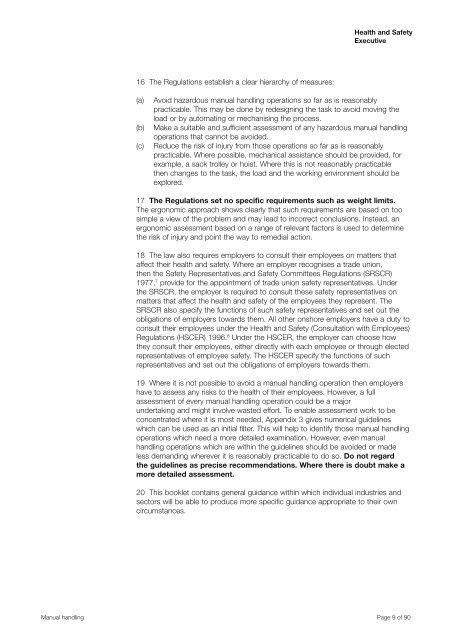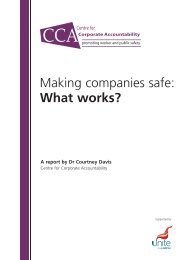Manual Handling Manual Handling Operations Regulations 1992 ...
Manual Handling Manual Handling Operations Regulations 1992 ...
Manual Handling Manual Handling Operations Regulations 1992 ...
Create successful ePaper yourself
Turn your PDF publications into a flip-book with our unique Google optimized e-Paper software.
Health and Safety<br />
Executive<br />
16 The <strong>Regulations</strong> establish a clear hierarchy of measures:<br />
(a)<br />
(b)<br />
(c)<br />
Avoid hazardous manual handling operations so far as is reasonably<br />
practicable. This may be done by redesigning the task to avoid moving the<br />
load or by automating or mechanising the process.<br />
Make a suitable and sufficient assessment of any hazardous manual handling<br />
operations that cannot be avoided.<br />
Reduce the risk of injury from those operations so far as is reasonably<br />
practicable. Where possible, mechanical assistance should be provided, for<br />
example, a sack trolley or hoist. Where this is not reasonably practicable<br />
then changes to the task, the load and the working environment should be<br />
explored.<br />
17 The <strong>Regulations</strong> set no specific requirements such as weight limits.<br />
The ergonomic approach shows clearly that such requirements are based on too<br />
simple a view of the problem and may lead to incorrect conclusions. Instead, an<br />
ergonomic assessment based on a range of relevant factors is used to determine<br />
the risk of injury and point the way to remedial action.<br />
18 The law also requires employers to consult their employees on matters that<br />
affect their health and safety. Where an employer recognises a trade union,<br />
then the Safety Representatives and Safety Committees <strong>Regulations</strong> (SRSCR)<br />
1977, 7 provide for the appointment of trade union safety representatives. Under<br />
the SRSCR, the employer is required to consult these safety representatives on<br />
matters that affect the health and safety of the employees they represent. The<br />
SRSCR also specify the functions of such safety representatives and set out the<br />
obligations of employers towards them. All other onshore employers have a duty to<br />
consult their employees under the Health and Safety (Consultation with Employees)<br />
<strong>Regulations</strong> (HSCER) 1996. 8 Under the HSCER, the employer can choose how<br />
they consult their employees, either directly with each employee or through elected<br />
representatives of employee safety. The HSCER specify the functions of such<br />
representatives and set out the obligations of employers towards them.<br />
19 Where it is not possible to avoid a manual handling operation then employers<br />
have to assess any risks to the health of their employees. However, a full<br />
assessment of every manual handling operation could be a major<br />
undertaking and might involve wasted effort. To enable assessment work to be<br />
concentrated where it is most needed, Appendix 3 gives numerical guidelines<br />
which can be used as an initial filter. This will help to identify those manual handling<br />
operations which need a more detailed examination. However, even manual<br />
handling operations which are within the guidelines should be avoided or made<br />
less demanding wherever it is reasonably practicable to do so. Do not regard<br />
the guidelines as precise recommendations. Where there is doubt make a<br />
more detailed assessment.<br />
20 This booklet contains general guidance within which individual industries and<br />
sectors will be able to produce more specific guidance appropriate to their own<br />
circumstances.<br />
<strong>Manual</strong> handling Page 9 of 90
















